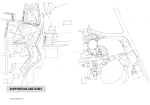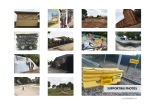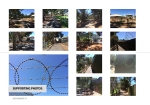
Architectural Design Studio 9 ‘Hopeful Monsters’ focused on urban scale design research with in Adelaide, South Australia. Looking specifically at zones along the Torrens River stretching between the CBD and the ocean the research aimed to evaluate the urban environment with specific consideration to the 65+ age group.
TORRENS PALIMPSEST X – Assignment 1 Mapping + Modelling Place
Working in pairs we under took a series of urban derive mapping exercises, investigating the experiential qualities of key moments occurring during movement through the broader site.
SUPPORTING IMAGES
A collection of the supporting sketches and photographs used to document the derives.
DIAGRAM CONVERSATION
The majority of this design studio involved group work. In the tutorial sessions we were encouraged to develop the practice of diagram conversation that uses drawing in the process of discussion. Moving from assignment 1 into assignment 2 this proved to be a key communication tool, particularly when working on the whole group model and within our pairs. Some of the images are quite beautiful and have been crucial in developing a strong narrative.
PALIMPSEST PROPOSITIONS – Assignment 2
Research Topic + Group Model
Working in pairs we investigated one of ten research topics to be incorporated into a tutorial group site analysis research report. Working with Ned Connelly we investigated Social Spaces, looking at thresholds between spaces, sites of interaction and levels of publicness. As a tutorial group we produced a 1:2500 site model.
SCHISM
Research Topic + Group Site Model
As part of the research I joined with a number of key students to work on the group site model titled – SCHISM. This became an exploratory exercise of process and experimentation. Taking the research analysis information and the concept of palimpsest, the model focuses on themes of disconnection and bridging, gravitating toward the river.
The SCHISM model has now been retained by the University of South Australia for display purposes.
AGEING/AGEIST/AGEISM – Assignment 3a Individual Proposal
Working individually I took the research from the previous assignments and started work on a more refined proposal for the Brickworks Site. This involved an analogue process of sketching and plaster modelling to generate a sculptural form and influence the program. Titled ‘Port + Passage’ it focused on developing a pathway through disconnected zones incorporating nodes of rich social activity.
SKETCH PLAN ITERATIONS
Using a process of applying layers of line work I started to explore the programmatic arrangement. This process was done in conjunction with sections and model massing in plaster.
MASSING MODELS
In conjunction with plan and section drawings I used 1:200 and 1:100 massing models to carve lines in plaster, drawing in 3D. Using water balloons to form voids shaped in the plaster I was able to explore the interior volumes.
PENCIL PEOPLE
To populate my perspective drawings I produce a number of hand drawn pencil sketches.
References
Giacomo Balla, divisionism and futurism, 1871-1912 / by Susan Barnes Robinson.
Apollonio, U 1973, Futurist manifestos, Thames and Hudson, London.
Lyotard, J & Mcleod, I 1990, Duchamp’s trans/formers, Lapis Press, Venice, CA.
Mcshine, K, D’harnoncourt, A, Art, PM & Art, MO 1973, Marcel Duchamp, Museum of Modern Art; distributed by New York Graphic Society, Greenwich, Conn, New York.
Greene, V & Museum, SR 2014, Italian Futurism 1909-1944 : reconstructing the universe, Guggenheim Museum Publications, New York.
Moss, EO 1993, Eric Owen Moss, Academy Editions ; Ernst & Sohn ; Distributed to the trade in the U.S.A. by St. Martin’s Press, London : Berlin : New York, NY.
Moss, EO 1991, Eric Owen Moss : buildings and projects, Rizzoli, New York.
Parkinson, G 2008, The Duchamp book, Tate ; Distributed in the United States and Canada by Harry N. Abrams, London : New York.
Altman, I & Zube, EH 1989, Public places and spaces, Plenum Press, New York.
Alexander, C, Ishikawa, S & Silverstein, M 1977, A pattern language : towns, buildings, construction, Oxford University Press, New York.




























































































